Krasnoyarsk
| Krasnoyarsk (in English) Красноярск (Russian) | |||||||||
|---|---|---|---|---|---|---|---|---|---|
| - City[1] - | |||||||||
| |||||||||
.svg.png) Location of Krasnoyarsk Krai in Russia | |||||||||
 Krasnoyarsk | |||||||||
|
| |||||||||
.svg.png) |
 | ||||||||
|
| |||||||||
| City Day | Second Sunday of June[2] | ||||||||
| Administrative status (as of March 2014) | |||||||||
| Country | Russia | ||||||||
| Federal subject | Krasnoyarsk Krai[1] | ||||||||
| Administratively subordinated to | krai city of Krasnoyarsk[1] | ||||||||
| Administrative center of | krai city of Krasnoyarsk, Krasnoyarsk Krai[3] | ||||||||
| Municipal status (as of February 2005) | |||||||||
| Urban okrug | Krasnoyarsk Urban Okrug[4] | ||||||||
| Administrative center of | Krasnoyarsk Urban Okrug[4] | ||||||||
| Head[5] | Edkham Akbulatov[6] | ||||||||
| Representative body | City Council of Deputies[5] | ||||||||
| Statistics | |||||||||
| Area (city) | 348 km2 (134 sq mi)[7] | ||||||||
| Population (2010 Census) | 973,826 inhabitants[8] | ||||||||
| - Rank in 2010 | 14th | ||||||||
| Population (2017 est.) | 1,083,865 inhabitants[9][10] | ||||||||
| Density | 2,798/km2 (7,250/sq mi)[11] | ||||||||
| Time zone | KRAT (UTC+07:00)[12] | ||||||||
| Founded | August 19, 1628[5] | ||||||||
| City status since | 1690[13] | ||||||||
| Postal code(s)[14] | 660000, 660001, 660003–660005, 660006, 660009–660023, 660025, 660027, 660028, 660030–660032, 660036, 660037, 660041–660043, 660046–660050, 660052, 660054–660056, 660058–660062, 660064, 660067–660069, 660071, 660073–660075, 660077–660079, 660091–660095, 660097–660100, 660113, 660115, 660118, 660119, 660121–660127, 660130–660133, 660135, 660136, 660880, 660890, 660899, 660911–660946, 660960–660966, 660970, 660999, 901175, 901177, 901179, 901181, 993600 | ||||||||
| Dialing code(s) | +7 391[15] | ||||||||
|
| |||||||||
| Krasnoyarsk on Wikimedia Commons | |||||||||
Krasnoyarsk (Russian: Красноя́рск; IPA: [krəsnɐˈjarsk]) is a city and the administrative center of Krasnoyarsk Krai, Russia, located on the Yenisei River. It is the third largest city in Siberia after Novosibirsk and Omsk, with a population of 1,035,528 as of the 2010 Census.[8] Krasnoyarsk is an important junction of the Trans-Siberian Railway and one of Russia's largest producers of aluminum.
The city is notable for its nature landscapes; author Anton Chekhov judged Krasnoyarsk to be the most beautiful city in Siberia.[16]
Geography
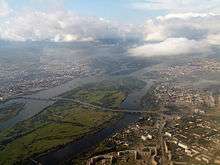
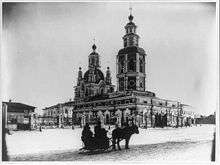
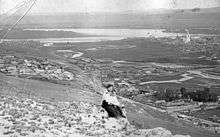
The total area of the city, including suburbs and the river, is 348 square kilometers (134 sq mi).[7]
The Yenisei River flows from west to east through the city. Due to the Krasnoyarsk hydroelectric dam 32 kilometers (20 mi) upstream, the Yenisei never freezes in winter and never exceeds +14 °C (57 °F) in summer through the city. Near the city center, its elevation is 136 meters (446 ft) above sea level. There are several islands in the river, the largest of which are Tatyshev and Otdyha Isles, used mainly for recreation.
To the south and west, Krasnoyarsk is surrounded by forested mountains averaging 410 meters (1,350 ft) in height above river level. The most prominent of them are Nikolayevskaya Sopka (notable for its ski jumping tracks), Karaulnaya Gora, and Chornaya Sopka, the latter being an extinct volcano.[17] The gigantic rock cliffs of the Stolby Nature Reserve rise from the mountains of the southern bank of the Yenisei, the western hills form the Gremyachaya Griva crest extending westwards up to the Sobakina River, the north is generally plain, except for the Drokinskaya Sopka hill, with forests to the northwest and agricultural fields to the north and east.
The major rivers in and near Krasnoyarsk are the Yenisei, Mana, Bazaikha, and Kacha Rivers, the latter flowing throughout the historical center of the city. Due to the nature of the terrain, a few natural lakes exist in the vicinity of Krasnoyarsk.
The forests close to the city are mostly pine and birch; further afield, aspen becomes dominant in many areas. The moss-covered fir and Siberian pine replaces other wood in the mountains westward of the Karaulnaya River, in about 15 kilometers (9.3 mi) to the west from the city, the forests to the south are mostly pine, fir and aspen.[18]
History
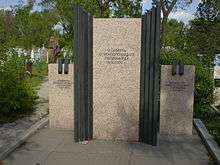
The city was founded on August 19, 1628[5] as a Russian border fort when a group of service class people from Yeniseysk led by Andrey Dubenskoy arrived at the confluence of the Kacha and Yenisei Rivers and constructed fortifications intended to protect the frontier from attacks of native peoples who lived along the Yenisei and its tributaries. Along with Kansk to the east, it represented the southern limit of Russian expansion in the Yenisei basin during the seventeenth century. In the letter to Tsar Michael I the Cossacks reported:
- ...The town of trunks (log buildings) we have constructed and around the place of fort, we the servants of thee, our lord, have embedded posts and fastened them with double bindings and the place of fort have strengthened mightily...
The fort was named Krasny Yar (Russian: Кра́сный Яр) after the Yarin (a dialect of Khakas) name of the place it was built, Kyzyl Char ('red steep-riverbank'),[19] which was translated as Krasny Yar (using the old meaning of krasny). An intensive growth of Krasnoyarsk began with the arrival of the Siberian Route (the road M53 nowadays) in 1735 to 1741 which connected the nearby towns of Achinsk and Kansk with Krasnoyarsk and with the rest of Russia.
In 1749, a meteorite with a mass of about 700 kilograms (1,500 lb) was found 230 km (140 mi) south of Krasnoyarsk. It was excavated by Peter Simon Pallas in 1772 and transported to Krasnoyarsk and subsequently to St. Petersburg. The Krasnoyarsk meteorite is important because it was the first pallasite ever studied and the first meteorite ever etched.
The name Krasnoyarsk was given in 1822 when the village of Krasny Yar was granted town status and became the administrative center of Yeniseysk Governorate. In the 19th century, Krasnoyarsk was the center of the Siberian Cossack movement. By the end of the 19th century, Krasnoyarsk had several manufacturing facilities and railroad workshops and an engine-house. Growth continued with the discovery of gold and the arrival of a railroad in 1895.
In the Russian Empire, Krasnoyarsk was one of the places to which political exiles were banished. For example, eight Decembrists were deported from St. Petersburg to Krasnoyarsk after the failure of the revolt.

After the Russian Revolution of 1917, during the periods of centralized planning (Five Year Plans) numerous large plants and factories were constructed in Krasnoyarsk: Sibtyazhmash, the dock yard, the paper factory, the hydroelectric power station (now the fifth largest in the world and the second in Russia), and the river port.
In 1934, Krasnoyarsk Krai, was formed, with Krasnoyarsk as its administrative center.
During Stalinist times, Krasnoyarsk was a major center of the gulag system. The most important labor camp was the Kraslag or Krasnoyarsky ITL (1938-c.1960) with the two units located in Kansk and Reshyoty. In the city of Krasnoyarsk itself, the Yeniseylag or Yeniseysky ITL labor camp was prominent as well during World War II (c. 1940-41).
During World War II, dozens of factories were evacuated from Ukraine and Western Russia to Krasnoyarsk and nearby towns, stimulating the industrial growth of the city. After the war additional large plants were constructed: the aluminum plant, the metallurgic plant, the plant of base metals and many others.
In the late 1970s, the Soviet Union began constructing a phased array radar station at Abalakova, near Krasnoyarsk, which violated the ABM Treaty. Beginning in 1983, the United States demanded its removal, until the Soviet Union admitted the radar station was a violation in 1989. Equipment was slowly removed from the site and by 1992 it was officially declared to be dismantled, though the equipment from the site was likely relocated to a new site near Komsomolsk-na-Amure.[20] Krasnoyarsk was also a home to Krasnoyarsk Northeast air base, which was turned into living blocks after the dissolution of the Soviet Union.
After the dissolution of the Soviet Union and beginning of privatization, many large plants and factories, such as the Krasnoyarsk Aluminum Plant, became owned by alleged criminal authorities and oligarchs, while others were declared bankrupt. The economic transition resulted in a dramatic rise in unemployment and numerous strikes.
The best known financial scandal of the second half of 1990s happened when ownership of the Krasnoyarsk Aluminum Plant by a known Krasnoyarsk businessman Anatoliy Bykov had been canceled after he was accused of murdering his partner, Vilor Struganov. The accusation eventually turned out to be false.[21] The Krasnoyarsk plant's ownership problems continue through the early 21st century since nearly all of them are owned either by monopolistic financial groups or by oligarchs.
Since the election of Pyotr Pimashkov as the mayor of Krasnoyarsk in 1996, the appearance of the city gradually improved: the old historical buildings were restored, the asphalt walkways were replaced with paving-stone, and numerous squares and recreation areas with fountains were either restored or constructed from scratch. Now the majority of the city keeps only a few traces of its former, drab, post-collapse look.
Administrative and municipal status
Krasnoyarsk is the administrative center of the krai.[3] Within the framework of administrative divisions, it is, together with one rural locality (the village of Peschanka) incorporated as the krai city of Krasnoyarsk—an administrative unit with the status equal to that of the districts.[1] As a municipal division, the krai city of Krasnoyarsk is incorporated as Krasnoyarsk Urban Okrug.[4]
City divisions
For administrative purposes, Krasnoyarsk is divided into seven city districts:
- Kirovsky
- Leninsky
- Oktyabrsky
- Sovetsky
- Sverdlovsky
- Tsentralny
- Zheleznodorozhny
Coat of arms

The first version of the Krasnoyarsk coat of arms was approved on March 12, 1804. A revised coat of arms, approved on November 23, 1851, had the golden figure of a lion placed on a red shield with a spade in the right fore paw and a sickle in the left fore paw, both made of the same metal. Since November 28, 2004 has the five-tower status crown of a federal subject administrative center.
Climate
Krasnoyarsk experiences a continental climate (Köppen climate classification Dfb) with long and very cold winters and short but warm summers. Its climate in July and during the winter is very similar to that of Fort McMurray and Winnipeg, Canada, the latter of which is a good deal further south geographically. Compared to Thompson, Manitoba, or Labrador City at a similar latitudes, Krasnoyarsk's winters are relatively mild. Compared to European cities on a similar latitude, Krasnoyarsk has much warmer summers, but much colder and longer winters (for example, Aberdeen, Scotland). The summer is also on average warmer than similar inland latitudes of Scandinavia, owing to Siberia's greater continentality. Very few major cities on earth have higher differentials between summer and winter temperatures than Krasnoyarsk.
| Climate data for Krasnoyarsk | |||||||||||||
|---|---|---|---|---|---|---|---|---|---|---|---|---|---|
| Month | Jan | Feb | Mar | Apr | May | Jun | Jul | Aug | Sep | Oct | Nov | Dec | Year |
| Record high °C (°F) | 6.0 (42.8) |
8.5 (47.3) |
17.9 (64.2) |
31.4 (88.5) |
34.0 (93.2) |
34.8 (94.6) |
36.4 (97.5) |
35.1 (95.2) |
31.3 (88.3) |
24.5 (76.1) |
13.6 (56.5) |
8.6 (47.5) |
36.4 (97.5) |
| Average high °C (°F) | −11.4 (11.5) |
−8.0 (17.6) |
−0.2 (31.6) |
7.8 (46) |
17.1 (62.8) |
22.4 (72.3) |
24.8 (76.6) |
21.8 (71.2) |
14.4 (57.9) |
6.4 (43.5) |
−3.4 (25.9) |
−9.4 (15.1) |
6.9 (44.4) |
| Daily mean °C (°F) | −15.5 (4.1) |
−12.8 (9) |
−5.7 (21.7) |
2.0 (35.6) |
10.4 (50.7) |
15.9 (60.6) |
18.7 (65.7) |
15.7 (60.3) |
8.9 (48) |
2.0 (35.6) |
−7.2 (19) |
−13.4 (7.9) |
1.6 (34.9) |
| Average low °C (°F) | −19.2 (−2.6) |
−16.9 (1.6) |
−10.1 (13.8) |
−2.6 (27.3) |
4.7 (40.5) |
10.3 (50.5) |
13.4 (56.1) |
10.8 (51.4) |
4.8 (40.6) |
−1.6 (29.1) |
−10.6 (12.9) |
−17.1 (1.2) |
−2.8 (27) |
| Record low °C (°F) | −52.8 (−63) |
−41.6 (−42.9) |
−38.7 (−37.7) |
−25.7 (−14.3) |
−11.2 (11.8) |
−3.6 (25.5) |
3.3 (37.9) |
−1.1 (30) |
−9.6 (14.7) |
−25.1 (−13.2) |
−42.3 (−44.1) |
−47.0 (−52.6) |
−52.8 (−63) |
| Average precipitation mm (inches) | 18 (0.71) |
13 (0.51) |
16 (0.63) |
32 (1.26) |
44 (1.73) |
63 (2.48) |
76 (2.99) |
67 (2.64) |
49 (1.93) |
43 (1.69) |
37 (1.46) |
30 (1.18) |
488 (19.21) |
| Average rainy days | 0.3 | 0.4 | 2 | 9 | 17 | 19 | 18 | 18 | 19 | 13 | 4 | 0.3 | 120 |
| Average snowy days | 24 | 21 | 17 | 14 | 4 | 0.1 | 0 | 0.03 | 2 | 14 | 23 | 25 | 144 |
| Average relative humidity (%) | 73 | 70 | 64 | 58 | 54 | 64 | 72 | 76 | 75 | 71 | 74 | 73 | 69 |
| Mean monthly sunshine hours | 63 | 100 | 171 | 216 | 251 | 280 | 281 | 237 | 160 | 111 | 58 | 41 | 1,969 |
| Source #1: Pogoda.ru.net[22] | |||||||||||||
| Source #2: NOAA (sun only 1961–1990)[23] | |||||||||||||
Demographics
The population count by year:[24][25]
| 1897 | 26,600 | 1962 | 465,000 | 1982 | 833,000 | 2000 | 875,500 | 2010 | 973,826 |
| 1923 | 60,400 | 1967 | 576,000 | 1986 | 885,000 | 2001 | 875,900 | 2011 | 979,600 |
| 1926 | 69,300 | 1970 | 648,100 | 1989 | 912,600 | 2003 | 909,300 | 2012 | 997,316 |
| 1939 | 186,100 | 1973 | 707,000 | 1992 | 925,000 | 2005 | 917,200 | 2013 | 1,016,385 |
| 1956 | 328,000 | 1976 | 758,000 | 1996 | 871,100 | 2008 | 936,400 | 2014 | 1,035,528 |
| 1959 | 412,000 | 1979 | 796,300 | 1998 | 875,300 | 2009 | 948,500 | 2017 | 1,083,865[9][10] |
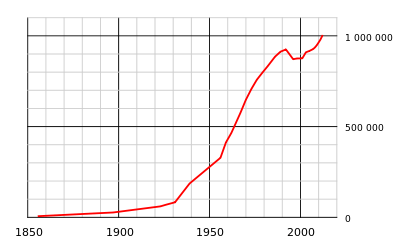
Population count by districts (2010 Census):[8]
- Kirovsky: 114,715
- Leninsky: 145,530
- Oktyabrsky: 153,112
- Sovetsky: 281,284
- Sverdlovsky: 130,596
- Tsentralny: 55,060
- Zheleznodorozhny: 93,529
The population of Krasnoyarsk includes a number of peoples, the most numerous are Russians, Ukrainians, Tatars, Germans, and Belarusians. Lately the number of Tajiks, Uzbeks and other Central Asian and Caucasian peoples has grown extensively because of the vast, often illegal immigration in search for work.
Another populous immigrant group is the Chinese who, unlike other foreign workers, are employed in much more lucrative areas and often form business partnerships with local companies. Many Chinese trade at the bazaars, and a special large Chinese bazaar named Sodruzhestvo (Russian for fellowship), and the Chinese Trading Town (known in Russian as Китайский торговый город) or colloquially Kitai-gorod on Strelka.
Architecture
There are a number of historical buildings in Krasnoyarsk, the oldest of them being the Intercession Cathedral (Russian: Покровский собор, 1785 to 1795, restored in 1977 to 1978). Other locally significant samples of Russian Orthodox architecture are the Annunciation Cathedral (Russian: Благовещенский собор, 1802–12), the Holy Trinity Cathedral (Russian: Свято-Троицкий собор, 1802–12), John the Baptist Church (Russian: Церковь Иоанна Предтечи, 1899, former episcopal residence), and the new Michael the Archangel Church (Russian: Церковь Архистратига Михаила, 1998 to 2003).
On the top of the Karaulnaya Hill, originally a pagan shrine, later occupied by the Krasnoyarsk fort watchtower, the Paraskeva Pyatnitsa Chapel (1804, rebuilt 1854-55) still stands. The chapel, displayed on the 10-ruble note, is one of the iconic images of the city. The chapel was abandoned and fell into disrepair during the Soviet era and only when Perestroyka came was it regained by the Yenisei bishopric.
Another unofficial symbol of Krasnoyarsk is the incomplete 24-story tower located at Strelka. Construction of the tower had been started just before Perestroyka and then frozen due to the administrative crisis. The outline of the tower is clearly seen from many places in the city.
A bridge near Krasnoyarsk carries the Trans-Siberian Railway across the Yenisei. This structure, one of the longest at the time, was constructed between 1893 and 1896 to an award-winning design by Lavr Proskuryakov. When approved for the inscription on the World Heritage List in 2003, the bridge was described by the UNESCO as "an early representation of a typical parabolic polygonal truss bridge in Russia" which became "a testing ground for the application of engineering theories and the development of new innovative solutions, which had numerous successors" ().
Among other notable buildings are the mansions of the merchant Nikolay Gadalov (beginning of the 20th century), the Roman Catholic Transfiguration Chapel (Russian: Преображенский собор, 1911, also known as the Krasnoyarsk Organ Hall), the Krasnoyarsk Krai Museum stylized as an Ancient Egyptian temple, the Krasnoyarsk Cultural/Historical Center and the triumphal arch at the Spit (2003), the regional administration building flanked with two towers known as the "Donkey Ears".
There are a number of two-story wooden houses in the city built mostly in the middle of the 20th century as temporary habitations. Many urbanized villages located inside the city keep the remnants of the traditional Russian village architecture: wooden houses with backyards, many somewhat dilapidated now but still inhabited.
Culture
There are a number of local holidays celebrated annually in Krasnoyarsk. The most significant holiday is the Day of the City celebrated in June, usually with a carnival. Other holidays and cultural events are the Mana Festival (Russian: Манский фестиваль. The celebrations take place on the outside of town, on the bank of river Mana) usually held on the last weekend in June with the traditional bard contest, the International Museum Biennale traditionally held in the Krasnoyarsk Cultural/Historical Center, the avant-garde Museum Night festival dedicated to the International Museum Day (May 18), the Jazz on Yenisey festival, the Stolbist Day held many times a year celebrating the traditions of mountain climbing in the Stolby national reserve, and the Bikers' Rally.
Krasnoyarsk has a number of local television companies and the highly developed telecommunications, many districts of the city have LAN-based broadband Internet access.
The city is also home to the Krasnoyarsk Children's Choir, a world-renowned choir that tours in many countries as The Little Eagles of Siberia.
Education and science
Next to Novosibirsk, Krasnoyarsk is a prominent scientific and educational center of Siberia, with over 30 higher education facilities, many of which are the branches of the Russian Academy of Science, and about 200 high schools. The most notable higher education institutes are:
- Siberian Federal University (Russian abbreviation is SFU), founded on November 4, 2006. The institution integrated four large higher education institutions (Krasnoyarsk State University, Krasnoyarsk State Academy of Architecture and Civil Construction, Krasnoyarsk State Technical University, State University of Non-Ferrous Metals and Gold)
- Krasnoyarsk State Pedagogical University (Russian abbreviation is KGPU), founded in 1932
- Siberian State Technological University (Russian abbreviation is SibGTU), the oldest in the city, founded in 1930 as the Siberian Institute of Forest
- Siberian State Aerospace University (Russian abbreviation is SibGAU), founded in 1960
- Krasnoyarsk State Medical University (Russian abbreviation is KrasGMU), founded in 1942
Like Novosibirsk, Krasnoyarsk has a special city district called Akademgorodok ("Academic Town"), where several scientific research institutes are located. Krasnoyarsk's Institute of Biophysics is known for a 1973–1985 experiment on ecological isolation of human beings (the "Bios Experiment"). Sukachev Institute of Forest, founded in 1944 at Moscow and relocated to Krasnoyarsk in 1959.
There are several museums in Krasnoyarsk. One is the Krasnoyarsk Regional Museum, containing historical items and exhibits of the region, including ancient history, native Siberians, and woolly rhinos.
The Krasnoyarsk zoo is also a major attraction for residents and tourists.
Transportation
Metro
An underground system (three lines) has been in planning and construction phases in Krasnoyarsk for decades. The first three stations have not been opened yet, but several construction sites around the city are visible. The date of the opening is uncertain, as works on the system have been stopped since 2010.
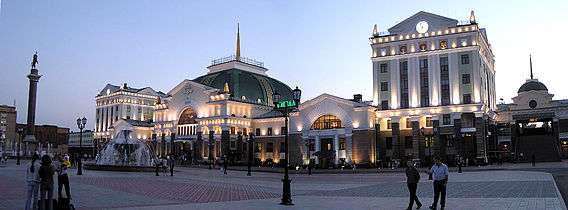
Railway
Krasnoyarsk lies on the Yenisei River and historically has been an important junction on the Trans-Siberian Railway. Krasnoyarsk-Passazhirsky(Russian: Красноярск-Пассажирский, lit. Krasnoyarsk-Passenger) is the main railway station of Krasnoyarsk. Long range trains of Trans-Siberian Railway stop at this station. There are some stations served by Elektrichka and there is Krasnoyarsk-East goods station 26.3 km east of Krasnoyarsk-Passazhirsky.
Airports
Krasnoyarsk was served by two airports: Yemelyanovo Airport is the main airport that handles both medium and long haul domestic plus international flights, and is located 27 kilometers (17 mi) northwest of the city.[26] The secondary Cheremshanka Airport used to handle short haul flights. Cheremshanka has lost its eminent role as the main base airport for an extensive network of local air services (MVL) in Krasnoyarsk Region formerly served by the local Aeroflot Krasnoyarsk Directorate. In December 2011 a fire broke out at the Cheremshanka airport which destroyed the terminal building and the air traffic control tower.[27]
Tourism

The most popular place of attraction for tourists visiting Krasnoyarsk is the huge national nature reserve Stolby ("pillars"), which covers an area of 470 square kilometers (180 sq mi) with numerous giant granite rocks formations up to 100 meters high, many of very extraordinary shapes. Stolby is also a major rock climbing location. Many local climbers intentionally do not use any belaying equipment and call their extreme sport stolbizm, known elsewhere as solo climbing.
Other popular showplaces include the Krasnoyarsk Hydroelectric Power Station dam, the Karaulnaya Gora hill with the Paraskeva Pyatnitsa Chapel, museums, theaters, etc.
Sports
Krasnoyarsk is a center of Siberian sports. Areas where Krasnoyarsk excels compared to other Russian cities include rugby union, bandy, and freestyle wrestling.
Yenisey was the Soviet bandy champions every year in the 1980s as well as in 1991. The first Russian title came in 2001. In 2014 they became champions of the Bandy Super League and had the highest average attendance, 5 747. In 2015 the league title was won again as well as in 2016.[28][29] At the 2019 Winter Universiade, bandy will feature as a demonstration sport for the first time and tournaments for both men and women will be held.[30] An indoor stadium will be built for the occasion. It is planned to be ready for use by the end of 2018.
The city is considered a stronghold of rugby union in Russia, to the extent that the Rugby Union of Russia was headquartered locally for many years. Two Krasnoyarsk clubs, Krasny Yar and Yenisey-STM, participate in the national Professional Rugby League, and Yenisey-STM qualified for the European Rugby Challenge Cup, the second-tier pan-European club competition, in 2015–16. Matches take precedence in the local media, and the city derby match can attract crowds of about 3000 - 5000. Many players of the Russian national rugby team hail from the area. Some of Russia's international rugby matches are played at the Central Stadium.
| Club | Sport | Founded | Current League | League Rank | Stadium |
|---|---|---|---|---|---|
| Yenisey Krasnoyarsk | Football | 1937 | National Football League | 2nd | Central Stadium |
| Sokol Krasnoyarsk | Ice Hockey | 1977 | Higher Hockey League | 2nd | Arena Sever |
| Yenisey Krasnoyarsk | Bandy | 1934 | Bandy Super League | 1st | Yenisey Stadium |
| Yenisey Krasnoyarsk | Basketball | 1993 | Professional Basketball League | 1st | Ivan Yarygin Sports Palace |
| Krasny Yar Krasnoyarsk | Rugby Union | 1969 | Professional Rugby League | 1st | Krasny Yar Stadium |
| Yenisey-STM Krasnoyarsk | Rugby Union | 1975 | Professional Rugby League | 1st | Avangard Stadium |
| Yenisey Krasnoyarsk | Volleyball | 1992 | Women's Volleyball Super League | 1st | Dvorkin Sports House |
| Yenisey Krasnoyarsk | Volleyball | 1993 | Volleyball Supreme League A | 2nd | Dvorkin Sports House |
Carolina Hurricanes left winger Alexander Semin is from Krasnoyarsk.
Future sport events
The 2019 Winter Universiade will be hosted by Krasnoyarsk.
Notable people
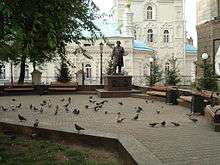
- Andrey Vorobyov, governor of Moscow Oblast
- Vasily Surikov, historic painter
- Viktor Astafyev, writer
- Pyotr Slovtsov, opera singer
- Andreï Makine, novelist
- Yevgeni Popov, writer
- Dmitri Hvorostovsky, operatic baritone
- Alexander Semin, ice hockey player
- Veniamin Kostitsin, painter
- Elena Khrustaleva, biathlete
- Evgeny Ustyugov, biathlete
- Evgeny Isakov, ice hockey player
- Helene Fischer, German singer and actress
- Valentin Danilov, Russian scientist
- Walter Ciszek, Polish-American Jesuit priest held captive here on suspicion of espionage for the Vatican
- Iya Gavrilova, ice hockey player
- Sergey Ivanovich Lomanov, bandy manager and former player
- Sergey Sergeyevich Lomanov, bandy player
- Viktoria Tereshkina, prima ballerina
Twin towns and sister cities
Krasnoyarsk is twinned with the following cities:
References
Notes
- 1 2 3 4 Law #10-4765
- ↑ Calend.ru. Krasnoyarsk (in Russian)
- 1 2 Law #10-4763
- 1 2 3 Law #13-3148
- 1 2 3 4 Charter of Krasnoyarsk
- ↑ Official website of Krasnoyarsk. Mayor and his deputies
- 1 2 Poexaly.ru. Krasnoyarsk Tourist Portal. Krasnoyarsk (in Russian)
- 1 2 3 Russian Federal State Statistics Service (2011). "Всероссийская перепись населения 2010 года. Том 1" [2010 All-Russian Population Census, vol. 1]. Всероссийская перепись населения 2010 года (2010 All-Russia Population Census) (in Russian). Federal State Statistics Service. Retrieved June 29, 2012.
- 1 2 Предварительная оценка численности постоянного населения на 1 января 2017 года и в среднем за 2016 год по городским округам и муниципальным районам Красноярского края
- 1 2 http://www.ias-statistika.ru/module/Free/OneNews.aspx?773
- ↑ The value of density was calculated automatically by dividing the 2010 Census population by the area specified in the infobox. Please note that this value may not be accurate as the area specified in the infobox does not necessarily correspond to the area of the entity proper or is reported for the same year as the population.
- ↑ Правительство Российской Федерации. Федеральный закон №107-ФЗ от 3 июня 2011 г. «Об исчислении времени», в ред. Федерального закона №271-ФЗ от 03 июля 2016 г. «О внесении изменений в Федеральный закон "Об исчислении времени"». Вступил в силу по истечении шестидесяти дней после дня официального опубликования (6 августа 2011 г.). Опубликован: "Российская газета", №120, 6 июня 2011 г. (Government of the Russian Federation. Federal Law #107-FZ of June 31, 2011 On Calculating Time, as amended by the Federal Law #271-FZ of July 03, 2016 On Amending Federal Law "On Calculating Time". Effective as of after sixty days following the day of the official publication.).
- ↑ (in Russian)Основание Красноярска
- ↑ Почта России. Информационно-вычислительный центр ОАСУ РПО. (Russian Post). Поиск объектов почтовой связи (Postal Objects Search) (in Russian)
- ↑ "Телефонные коды Красноярский край". Ruspostindex.ru. Retrieved 2013-03-26.
- ↑ Anton Chekhov, "The Crooked Mirror" and Other Stories, Zebra Book, 1995. See page 200 for English translation of his journey through Siberia.
- ↑ "Атлас достопримечательностей". Krskstate.ru. Retrieved 2013-03-26.
- ↑ Окрестности Красноярска. Карта. ФГУП Госцентр "Природа", 2003 г.
- ↑ Бутанаев В. Я. "Топонимический словарь Хакасско-Минусинского края". Абакан, 1995.
- ↑ Pike, John. "Yeniseysk (Krasnoyarsk)". Globalsecurity.org. Retrieved 2013-03-26.
- ↑ Latynina, Yulia, “Today, Let’s Go Inside the Other Russia”, Moscow Times, 21 February 2001
- ↑ "Pogoda.ru.net (Weather and Climate-The Climate of Krasnoyarsk)" (in Russian). Weather and Climate. Retrieved 29 November 2015.
- ↑ "Krasnojarsk (Krasnoyarsk) Climate Normals 1961–1990". National Oceanic and Atmospheric Administration. Retrieved November 29, 2015.
- ↑ "За 2008 год население Красноярска увеличилось на 1,2% / Новости /". Newslab.ru. Retrieved 2013-03-26.
- ↑ Народная энциклопедия "Мой город". Красноярск (Красноярский край) (in Russian). Mojgorod.ru. Retrieved 2013-03-26.
- ↑ Yemelyanovo International Airport - About/General Information
- ↑ The Aviation Herald - Tower and terminal of Krasnojarsk Cheremshanka Airport burned down
- ↑ https://translate.google.com/translate?hl=en&sl=ru&u=http://www.rusbandy.ru/news/9039&prev=search
- ↑ https://i.ytimg.com/vi/_Y0lhvnE7pU/hqdefault.jpg
- ↑ Sports
- 1 2 3 4 5 6 7 8 9 10 11 12 13 14 15 Контакты с иностранными городами Внешние связи — официальный сайт администрации города Красноярска (in English) (in Russian) (in German)
Sources
- Законодательное собрание Красноярского края. Закон №10-4765 от 10 июня 2010 г. «О перечне административно-территориальных единиц и территориальных единиц Красноярского края», в ред. Закона №7-3007 от 16 декабря 2014 г. «Об изменении административно-территориального устройства Большеулуйского района и о внесении изменений в Закон края "О перечне административно-территориальных единиц и территориальных единиц Красноярского края"». Вступил в силу 1 июля 2010 г. Опубликован: "Ведомости высших органов государственной власти Красноярского края", №33(404), 5 июля 2010 г. (Legislative Assembly of Krasnoyarsk Krai. Law #10-4765 of June 10, 2010 On the Registry of the Administrative-Territorial Units and the Territorial Units of Krasnoyarsk Krai, as amended by the Law #7-3007 of December 16, 2014 On Changing the Administrative-Territorial Structure of Bolsheuluysky District and on Amending the Krai Law "On the Registry of the Administrative-Territorial Units and the Territorial Units of Krasnoyarsk Krai". Effective as of July 1, 2010.).
- Законодательное собрание Красноярского края. Закон №10-4763 от 10 июня 2010 г. «Об административно-территориальном устройстве Красноярского края», в ред. Закона №8-3263 от 19 марта 2015 г. «О внесении изменений в Закон края "Об административно-территориальном устройстве Красноярского края"». Вступил в силу на следующий день после официального опубликования. Опубликован: "Ведомости высших органов государственной власти Красноярского края", №31(402), 28 июня 2010 г. (Legislative Assembly of Krasnoyarsk Krai. Law #10-4763 of June 10, 2010 On the Administrative-Territorial Structure of Krasnoyarsk Krai, as amended by the Law #8-3263 of March 19, 2015 On Amending the Krai Law "On the Administrative-Territorial Structure of Krasnoyarsk Krai". Effective as of the day following the official publication.).
- Законодательное собрание Красноярского края. Закон №13-3148 от 25 февраля 2005 г. «О наделении муниципального образования город Красноярск статусом городского округа». Вступил в силу через десять дней после официального опубликования. Опубликован: "Ведомости высших органов государственной власти Красноярского края", №13, 4 апреля 2005 г. (Legislative Assembly of Krasnoyarsk Krai. Law #13-3148 of February 25, 2005 On Granting Urban Okrug Status to the Municipal Formation of the City of Krasnoyarsk. Effective as of the day ten days after the official publication.).
- Красноярский городской Совет. Решение №В-62 от 24 декабря 1997 г. «Устав города Красноярска», в ред. Решения №6-90 от 16 декабря 2014 г. «О внесении изменений в Устав города Красноярска». Вступил в силу в соответствии со статьёй 86. Опубликован: "Городские новости", №4, 16 января 2008 г. (Krasnoyarsk City Council. Decision #V-62 of December 24, 1997 Charter of the City of Krasnoyarsk, as amended by the Decision #6-90 of December 16, 2014 On Amending the Charter of the City of Krasnoyarsk. Effective as of the date determined in accordance with the provisions set forth in Article 86.).
External links
| Wikivoyage has a travel guide for Krasnoyarsk. |
- Official website of Krasnoyarsk (in Russian)(in English)
- Interactive online map of Krasnoyarsk (in Russian)
- The Siberian Federal University homepage (in English)(in Russian)(in German)(in Spanish)(in Chinese)
 "Krasnoyarsk". Encyclopædia Britannica. 15 (11th ed.). 1911.
"Krasnoyarsk". Encyclopædia Britannica. 15 (11th ed.). 1911.
.jpg)


